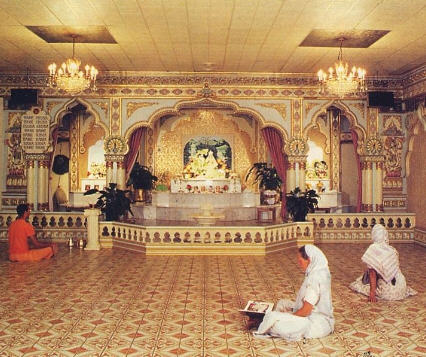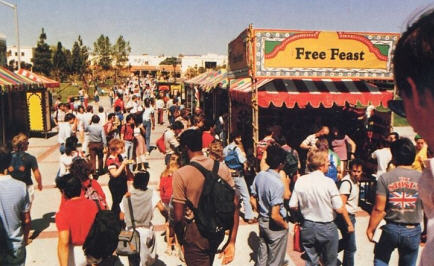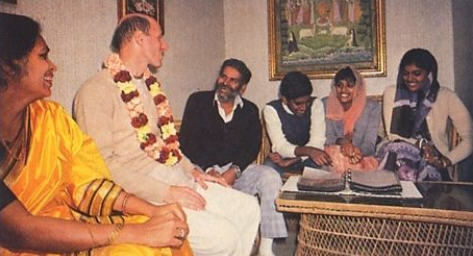Devotees of Krsna have become widely appreciated as a vital and colorful part
of this city of economic opportunity and religious heritage.

ISKCON San Diego Temple
San Diego, famous as a port for the U.S. Navy's Pacific fleet, as a resort town with a subtropical climate that draws winter tourists to its parks and beaches, and as a developing center for high-tech industries, began its history in 1769 as the first Spanish mission in California. Exactly two centuries later, in 1969, devotees of the International Society for Krishna Consciousness opened their first center and began their own missionary activities. During the past fifteen years they have made a profound impact upon the cultural life of the city.
What is it that so many San Diegans find attractive about the Krsna consciousness movement? The food is one thing. Like many other Southern California residents, people in San Diego are becoming increasingly aware of the health benefits of a vegetarian diet. Through many food-related programs the members of San Diego's Krsna consciousness community are at the forefront of the trend against meat-eating. The Indian spiritual tradition represented by the Krsna consciousness movement rejects animal slaughter as needless, unethical violence.
In the Bhagavad-gita, Lord Krsna, the Supreme Personality of Godhead, says, "If one offers to Me with love and devotion a leaf, a flower, a fruit, or water, I will accept it." Since time immemorial devotees have prepared vegetarian foods and offered them to Lord Krsna as an act of devotion. Food so offered becomes spiritual in quality, and it is customary to distribute this consecrated food, called prasadam, to the general public.
Thus for many thousands of San Diegans, the first taste of Krsna consciousness has been a plate of the delicious spiritual vegetarian food served at the movement's cultural festivals, nightly dinners, Sunday feasts, or two very popular Govinda's natural foods restaurants.
"A nonvegetarian who strolls into Govinda's, a comfortable, unpretentious establishment, may feel quite virtuous when he contemplates the eye-catching array of beautifully fresh and green vegetables spread out on the salad bar." wrote David Nelson, restaurant reviewer for the San Diego edition of the Los Angeles Times. Describing the entrees, he stated, "Most are colorful and all are impeccably fresh. Sesame seeds and wedges of beautifully red tomato floated atop the split yellow pea soup. . . . The most delicious foods here are the homemade breads, which are brought out hot several times during the course of the evening. . . . Indian music plays quietly over the sound system, and, for those so inclined, there is a video room in which guests may watch videotapes about various aspects of Indian culture." The boutiques and gift shops adjoining each restaurant offer transcendental literature, Indian fashions, silk paintings, oriental rugs, incense, and even Indian spices and bulk grains and flours for those interested in duplicating their favorite Govinda's restaurant recipes.
Here are some sample comments from suggestion cards filled out by Govinda's customers: "It's a pleasure to come to a restaurant where you can be assured of nutritious well-prepared food in an atmosphere of respect for God. Keep up the good work!" . . . "I'm really against exploiting animals for food, and I'm glad to find an all-vegetarian restaurant with such good food and reasonable prices." . . . "Great! There should be as many Govinda's as 7-11's."

The Festival of India at San Diego
Gunagrahi Goswami, who founded the restaurants, says, "I'm happy that so many people here in San Diego are enjoying the elegant vegetarian dining experience we're working so hard to offer them at Govinda's. And we're also providing an opportunity for them to learn more about Krsna consciousness. A good many of our patrons become very interested in the spiritual aspects of our approach to eating. They learn how people definitely suffer a bad karmic reaction to killing animals. They inquire about how to prepare and offer their own food as a spiritual offering to Lord Krsna."
The devotees of Krsna are particularly concerned with the plight of San Diego's homeless and hungry. Through ISKCON's Hare Krishna Food for Life program, which now operates throughout the world, the members of the San Diego Krsna consciousness community are providing free noon meals to thousands. Leroy Martin, a district chief of the County of San Diego Department of Social Services, reported, "There is a tremendous amount of poverty in our community. Clients are seen in our office on a daily basis who have not eaten and are hungry." Speaking of the Hare Krsna movement's free-food program, he noted its "reliability and efficiency." He added, "Clients and community members anticipate them being here….Some clients stated that they had walked a considerable distance specifically for the noon meal." Mr. Logan observed that Hare Krishna Food for Life "is able to provide meals at a lower cost because of an all-volunteer staff." He concluded. "I would strongly recommend that the Hare Krishna Food for Life free meals program he expanded, I would also support their request for additional funds to operate their program. I think the Hare Krishna Food for Life workers have done an excellent job. Clients and community residents have appreciated their service."
But the most heartfelt words of appreciation come from those who actually receive the meals. Says Kenneth Cooley, thirty-three and unemployed, "This is great. If you people hadn't come today. I would not have had anything at all to eat."
Recently Hare Krishna Food for Life qualified to receive government food supplies. Large trucks regularly arrive at the Food for Life kitchen to drop off supplies that will he used to prepare meals for the hungry. A typical load: two thousand pounds of butter, a thousand pounds of powdered milk, and two hundred pounds of peanut butter.
With the enthusiastic endorsement of Mexican officials, Hare Krishna Food for Life volunteers from San Diego are also distributing free meals in the barriosof Tijuana. There the emphasis is on children. Mrs. Rosario Cecelia, head of a Tijuana neighborhood council, says, "There are many mothers in this neighborhood with six or more children who do not get enough food for themselves or their children. There is no way we can thank you enough for your help."
A Major Cultural Center
During the course of each year, tens of thousands of San Diego residents enjoy the Sunday evening Festival of India at the Hare Krsna movement's temple in Pacific Beach. This unique, multifaceted cultural experience brings alive the art, music, dance, drama, and philosophy of ancient India's timeless Vedic culture. Stepping into the temple room, which is beautifully decorated with intricate bas-relief sculpture, classic Indian art, brilliant chandeliers, and a bubbling marble fountain, guests feel transported from San Diego to the enchanting, vibrant atmosphere of the spiritual world.
Often, the highlight of the evening is a talk on the philosophy of theBhagavad-gita given by the resident spiritual master, Srila Ramesvara Swami, a member of the Hare Krsna movement's Governing Body Commission and a pioneer in spreading Krsna Consciousness through book publication and distribution. Recently devotees delivered sixty thousand packages of free books to homes in the San Diego area. "We're making a valuable contribution in the city's cultural life," says Srila Ramesvara Swami. "We're offering people the most complete understanding of vegetarianism and reincarnation. We are explaining to people how world events that affect every one of us, including the issues of war and peace, the environment, and the economy, are under the control of karma.We're offering a means for people to elevate their consciousness and more perfectly understand God and their personal relationship with Him."
For many years, devotees have also held a nightly vegetarian dinner. The guests include many students from the nearby San Diego campus of the University of California and quite a number of young professionals. "Krsna consciousness always has had a special attraction for the students." explains the temple president, Badarinarayana dasa. "But now as we ourselves enter our thirties and forties, marry and raise families, and become involved in activities that require the same skills and talents that are required in business and the professions, we find that we're naturally attracting more people of our own age group. We have a lot of what you call 'yuppies' coming to the temple these days."
"San Diego is now the eighth biggest city in America," he adds. "After Houston and Phoenix, it's the fastest growing. It's Southern California's answer to Silicon Valley. But there's still a very relaxed vacationland mood here. People are competitive, but they're also interested in enjoying themselves.
"So what Krsna consciousness has to offer them is a powerful technique of meditation that fills the spiritual vacuum created by our overly materialistic society. The very word Krsna means 'the reservoir of pleasure,' and by understanding our spiritual identity and our relationship with Krsna, we can share in that higher pleasure. This elevates the quality of our enjoyment of life."
Tom Sepa, a career consultant who regularly attends the evening dinner, says, "The food is great, and the fact that it's free from karma makes it even better. I like the people here. It's a great alternative to the nightclub scene. I'm not into going to bars. The temple is part of my social life. I feel when I come here I can be myself without having to get involved in the usual games. I'm also glad for the opportunity to learn more about the teachings of Krsna consciousness. I've gotten a lot of peace of mind from coming here."
Joanne Wooding, thirty-eight, who works as a secretary, says, "I've been coming to the temple for a couple of months. I immediately felt right at home. I've been a vegetarian for several years, so when I moved to San Diego a few months ago I found it difficult to eat anywhere or have any kind of social life, mainly because of the difficulties involved in being around people who eat meat. I really enjoy being with the Hare Krsna devotees. I feel a lot less stress in my life since I've been visiting here. Instead of feeling I'm all by myself, I get a lot of reinforcement for my lifestyle. I used to be an animal rights activist, but I began to feel uncomfortable with a lot of people who make political agitation to save the whales and seals but who are themselves flesh-eaters. So I very much appreciate the Hare Krsna people's policy of protecting all of God's creatures."
"I always enjoy coming here," says Barb Manning, twenty-five. "I'm very impressed with the delicious food, the peaceful atmosphere and the graceful service. I especially like how nice and clean it always is. Sometimes I stay after dinner and take part in the chanting and the philosophy class. The altar is very attractive, and I enjoy looking at the Deities. The temple is a place where I can come and meditate upon God as a real person. Coming here has made me more conscious of my spiritual life."
Many of these newcomers have become members of the temple's growing congregation, the Friends of Lord Krishna (FOLK). While keeping their own jobs and homes, they practice Krsna consciousness and contribute a portion of their income to the temple, much as any member of the more established churches would do.
Larry Gatpandan, who paints airplanes at the Naval Air Station on North Island, is a member of FOLK. "Krsna consciousness," he says, "has a very satisfying spiritual philosophy, a very clear conception of God's personal nature and of how we can use our talents and abilities to serve Him.
"I've also learned to practice the world's oldest and most powerful system of meditation the chanting of the Hare Krsna mantra on meditation beads. By doing this on a regular basis, I've developed a sense of inner satisfaction and peace of mind. I'm a better person because of it, a better husband, a better father.
"Now, when the people I meet learn that I'm a member of the Hare Krsna religion, they aren't as surprised as people used to be. It's a sign of the times, I suppose, that the movement is expanding into the general population. The Hare Krsna people are even on television now."
It's a fact regular Krsna conscious television programming is available to San Diego residents through local cable networks. Currently running is Inside Hare Krishna, a highly popular thirteen-part series giving a general introduction to the lifestyle, philosophy, and cultural contributions of the Hare Krsna movement. Jody Catlow, community programming director for the Southwest Cable Network, says, "The quality of the devotees' productions is so excellent that we'll take whatever they give us."

Mahatma Dasa Talks With ISKCON life
San Diego also serves as the Hare Krsna movement's headquarters for adjacent areas of the Southwest. Gunagrahi Goswami, in a large motorhome he has outfitted as a traveling temple, periodically embarks on journeys that take him and his traveling companions far and wide for the special purpose of visiting people who are interested in Krsna consciousness but live far from any temple.
A highly visible sign of the authenticity of the Krsna consciousness movement is the regular attendance by members of San Diego's Indian community at temple functions. Tirumalesa Duvvuri, an aeronautical engineer with the Cal-Space company, says, "Krsna has been worshiped in temples throughout India for thousands of years. For myself and my family, I am very grateful to the Krsna devotees for giving us the chance to worship God in the way to which we have been accustomed."
The San Diego Hare Krsna center regularly hosts visiting classes from local universities and colleges. Professor Lance Nelson, of the University of San Diego's department of religious studies, recently wrote to the temple, "The love of Krsna, which runs so deep in the heart of India, has produced some of the most elevated expressions of religious devotion in human history. We in San Diego are enriched in having representatives of this tradition like yourself as a part of our community. My students were particularly impressed by your lifestyle of dedication to spiritual ideals. Your example is an inspiration for those of us who are overly caught up in modern mass society, which tends to emphasize conspicuous and unnecessary material consumption at the expense of that which really counts, our relationship to God. I look forward to my next visit with you."
